Ask any corporate executive to name big, lose-sleep-over issues, and it’s likely that finding and retaining quality employees loom near the top of the list. Over the past couple of decades, companies have addressed those two perennial challenges in part with benefits and perks that make old-school insurance and retirement packages seem downright fuddy-duddy in comparison.
On-site hair salons, bike repair shops, dry cleaners and fitness centers? Check. Paid time off for volunteering? Check. Dog parks and pet insurance? Check. Reimbursement for adoption fees, daycare costs and embryo-freezing services? Check, check and check. Workplaces across the country offer all of these and many more to sweeten the pot, particularly in competitive, Millennial-driven markets.
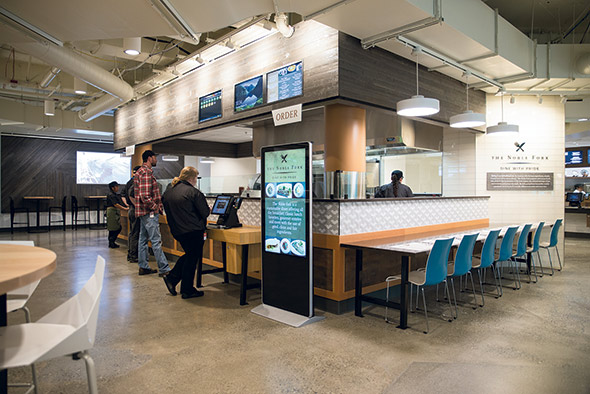 Noble Fork is a Slow Food-inspired sustainable diner option touting “good, clean and fair ingredients.” It’s part of Microsoft’s new Café 25, a multiconcept, zero-waste facility. Photo courtesy of Dining at Microsoft
Noble Fork is a Slow Food-inspired sustainable diner option touting “good, clean and fair ingredients.” It’s part of Microsoft’s new Café 25, a multiconcept, zero-waste facility. Photo courtesy of Dining at Microsoft
It’s become a what-else-can-you-do-for-me workaday world, and within that realm, if old-school benefits no longer suffice, neither do old-school approaches to corporate dining. The traditional company cafeteria, where cheap or free food and on-site convenience were once enough, now gives way to next-gen initiatives designed to satisfy an increasingly diverse, flexible, engaged and food-savvy workforce.
A fundamental change in the segment has been its evolution from what was typically a highly subsidized amenity to what today is a P&L-driven, compete-with-the-street environment, according to Victoria Vega, vice president of the Corporate Culinary Group at Unidine Corporation, a Boston-based food and dining services management firm. The 30-year industry veteran, who is also a past president of the Society for Hospitality and Foodservice Management, says her message to her teams today is: “In workplace hospitality, while you may consider everyone in your office building to be a captive population, you always need to captivate them.”
 Corporate cafeterias have given way at many companies to design-forward, contemporary food halls. Photo courtesy of Restaurant Associates
Corporate cafeterias have given way at many companies to design-forward, contemporary food halls. Photo courtesy of Restaurant Associates
And for workplace hospitality operators today, captivating customers means staying on top of significant changes on both the workplace and hospitality sides of the equation.
Real Estate Shrinks
Many workplaces continue to shrink. Work-from-home, virtual offices and transient workforce trends, combined with real-estate cost pressures, mergers and acquisitions, have many companies downsizing their footprints. The upshot: There’s often less space devoted to amenities such as traditional on-site dining.
“You no longer see the bowling alley-sized cafeterias that you did 15 years ago,” Vega notes. “They’re simply not necessary in part because of how people work today. They’d never be filled. And from a client or owner perspective, depending where your building is located, the cost of that real estate also drives footprints.”
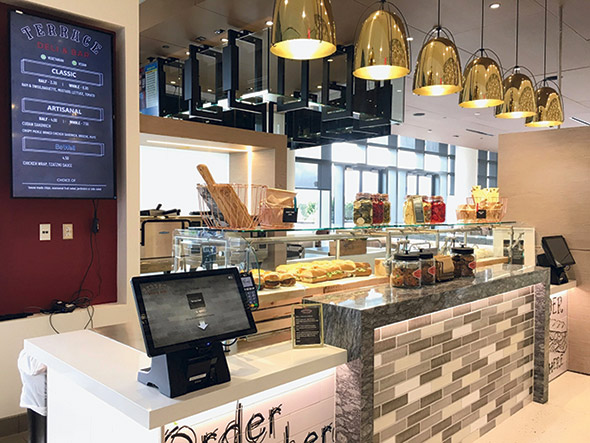 Demand is growing among Restaurant Associates’ corporate dining clients for small-footprint, retail-style food solutions such as coffee bars and high-quality grab-and-go with self-checkout convenience. Photo courtesy of Restaurant Associates
Demand is growing among Restaurant Associates’ corporate dining clients for small-footprint, retail-style food solutions such as coffee bars and high-quality grab-and-go with self-checkout convenience. Photo courtesy of Restaurant Associates
Sam Souccar, senior vice president of creative services at New York-based hospitality company Restaurant Associates (RA), also sees a downward trend in corporate square footage overall and in space devoted to foodservice. With RA’s corporate dining clients concentrated in major urban centers, the high cost of real estate gets most of the credit.
“It really starts with real estate and associated costs,” Souccar says. “Many clients are looking at both build-out and operating costs and, in urban locations, are allotting significantly less space for corporate dining. It may not be the case in smaller or more suburban areas where real estate costs aren’t such an issue, but the biggest trend we’re seeing is toward small-footprint solutions.”
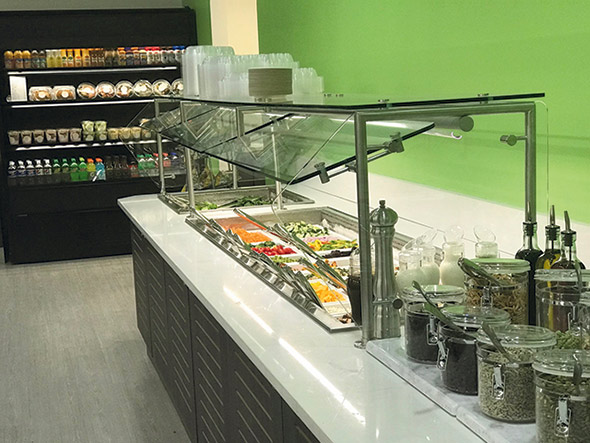 With available real estate shrinking in many corporate settings, organizations are incorporating smaller, more versatile foodservice options and highlighting grab-and-go. Photo courtesy of Unidine Corporation
With available real estate shrinking in many corporate settings, organizations are incorporating smaller, more versatile foodservice options and highlighting grab-and-go. Photo courtesy of Unidine Corporation
Souccar points out that in many cases, developers contribute to a shift toward allocating less space to dining by adding restaurants to their mix. “They see value in food to attract both tenants and the public to their buildings and, as such, are subsidizing rents for food outlets,” he says. “A potential office tenant may have its own foodservice, but if the landlord can say, ‘Hey, listen, there’s an artisanal coffee shop and a Mediterranean fast-casual and a great pizza place in the building,’ that building becomes a lot more attractive.”
Having restaurant choices right in the building and/or in the surrounding neighborhood allows some companies to nurture distinctly modern, smaller-scale takes on foodservice, as well as to promote a culture of supporting local businesses.
When cloud computing company Salesforce reimagined its corporate headquarters in San Francisco, for instance, it created an environment in which food plays a role but in a way that’s in tune with how more employees today want to work — in flexible, comfortable, design-forward environments that foster engagement, creativity and collaboration.
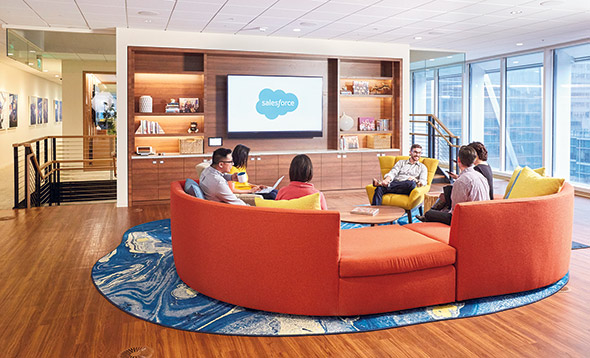 Instead of dining halls, the new offices at Salesforce in San Francisco include social lounges on employee floors. They’re flex spaces where employees can relax, recharge and collaborate with easy access to a variety of snacks and beverages. Photo courtesy of Salesforce
Instead of dining halls, the new offices at Salesforce in San Francisco include social lounges on employee floors. They’re flex spaces where employees can relax, recharge and collaborate with easy access to a variety of snacks and beverages. Photo courtesy of Salesforce
Rather than incorporate trendy dining options, Salesforce bucks that widely hailed tech-company strategy and encourages employees to purchase meals off campus, channeling sales to local restaurants and retailers. Instead of dining halls, its new offices include flex spaces where employees can relax, recharge and collaborate with easy access to a variety of snacks and beverages.
“We design our office to feel like home, with residential fits and finishes. As part of our design philosophy, the focal point of our employee floors are expansive kitchen spaces known as social lounges,” explains Benny Ebert-Zavos, manager of real estate communications at Salesforce. “These areas are flexible spaces that feature a wide range of seating options where employees can meet with coworkers, grab a snack, live-stream company events, host festivities and more.”
And rather than reserve the building’s top floor for senior executive offices, Salesforce turned the San Francisco building’s 61st floor into what it calls its Ohana (Hawaiian for “family”) floor. The open event space includes an exhibition kitchen, barista bar and 360-degree views.
Habits Shift, Tech Enables
Approaches such as Salesforce’s point to shifting demand in some segments that impacts both facility design and foodservice offerings. As 9 to 5 gives way to plugged-in-anytime availability and as Millennial and Gen Z employees continue to redefine workplace ideals, corporate dining programs keep evolving to meet their needs.
Vega sees design as a key part of that evolution, with cafe spaces being reimagined for broader use. “The cafe is becoming a more integral experience,” she says. “Seating areas have become conference rooms, huddle spaces, thought-incubation centers. It’s no longer about sitting down at a four-top in a designated space downstairs to have lunch with colleagues. You now have open spaces with flexible soft seating, workstations and charging ports everywhere; spaces that can easily be segmented into different functional rooms and used for after-hours events. Employers are encouraging employees to get out of their offices and do their work in the common area. That’s when team members interact and network and support ideas and each other. Organizations see that as improving morale, boosting productivity and the company’s ability to attract and retain talent. How dining and the physical spaces work together plays a key role in that.”
Operators continue to change as well, extending defined meal periods of the past or supplementing meal periods with on-demand, convenience-driven corporate dining initiatives.
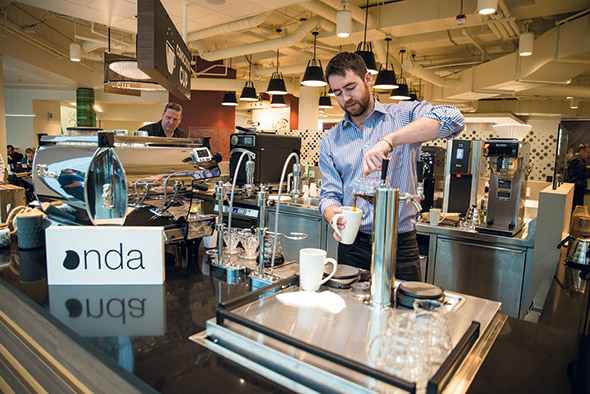 At Café 25, Microsoft partnered with Onda Origins, a local specialty coffee company that uses blockchain technology to trace coffee from origin to cup and virtual reality to share the experience.
At Café 25, Microsoft partnered with Onda Origins, a local specialty coffee company that uses blockchain technology to trace coffee from origin to cup and virtual reality to share the experience.
“With technology, workplaces have become 24-7,” Vega notes. “That’s changing the types of operations clients are looking for. While all employees might not go down to the cafe, there’s growing interest in solutions such as honor pantries, micro markets, coffee bars and pop-up restaurant concepts or chef’s stations. They might be positioned on several floors, or on the other side of the building from the cafe. Increasingly, we’re bringing these types of options closer to the customers, making them both compelling and convenient.”
For corporate dining operators to pursue such strategies, mobile, self-venting equipment and small-footprint, multifunction tools such as combi ovens are mission-critical today, she says.
Souccar agrees, noting flexible, mobile food options that satisfy customer demands for quality and convenience represent strong opportunities for corporate dining programs, particularly as they strive to compete with the street. He suggests restaurants and retailers have raised the bar significantly on grab-and-go, for example, leading on-site operators to follow suit.
“Today, you have everyone from the Pret A Mangers of the world to Whole Foods enticing customers with quality grab-and-go programs,” Souccar says. “Even pharmacies like CVS and Duane Reade have stepped up their game on grab-and-go. So that’s an increasingly important piece for our clients. The same is true with coffee. In many locations, even if we have just a small footprint to work with, a barista bar fitted with sleek, artisanal coffee equipment and offering a limited menu of fresh sandwiches, soups and snacks can become a focal point. Or maybe we do a flexible cold action station for focused takeaway items like sushi or poke bowls.”
A full spectrum of dining options exists for employees at Microsoft headquarters in Redmond, Wash., but among the most successful aspects of the company’s program has been the c-store-inspired Market@ Stores concept, launched in 2013. More than 25 Market@ Stores operate across the Microsoft campus, each measuring just 150 to 250 square feet. All provide high-quality, grab-and-go fare that fuels employees any time of day or night.
Stocked with fresh sandwiches, snacks, beverages and microwaveable entrees, the stores are located within and adjacent to cafes, operating during and after hours, as well as in farther-flung sections of campus where access to cafes is less convenient. Top-selling items include bulk trail mixes, nuts and chocolates, whole fruits, string cheese and packaged sandwiches sourced from select local vendors.
“The c-store format solves lot of problems for us,” says Mark Freeman, who retired in September after serving as senior manager of global dining services at Microsoft for 12 years. “We have associates who work all times of the day, so it provides a non-staffed solution that gets the customer what they need when they need it, even if they don’t have a cafe nearby. It was born out of the cashless and cashless/cashierless POS system that we use, which allows us to be able to put these markets in without having to staff them.”
Certainly, as in the commercial restaurant market, technological advancements change corporate dining operations, too. Momentum continues to build behind tech-enabled self-service, from kiosk and mobile app order placement to cashless payment systems that speed service and maximize convenience.
Vega hails self-checkout technology as an important opportunity for corporate clients, enabling them to simultaneously expand hours, grow revenues, satisfy customer demand and gain labor efficiencies. Unidine offers the technology to its clients and touts success with its app-driven Ready Fresh program, via which employees can order and pay ahead for quick pickup later. At some locations, the management firm now offers delivery service as well.
“There isn’t the backlash that we saw when we experimented with things like self-checkout even just three years ago,” Souccar adds. “In this regard, retail is making it easier for us, in the same way Starbucks paved the way for foodservice to charge $4 for a cup of specialty coffee. Consumers are trained at pharmacies, at Home Depot, at the supermarket to use self-checkout. They’re comfortable with it and even start to expect it. In some of Restaurant Associates’ newer installations, especially in companies with a younger demographic, we now see longer lines at self-checkout stations than at attended cashier stations. Many customers would rather not interact with someone, and as upward of 85 percent of our total transactions are credit and debit anyway, it’s not a tall ask to not accept cash.”
Self-service transactions may be more common, but maintaining a hospitality-focused environment is still important, Souccar emphasizes. In fact, he says, technology enables operators to divert labor from functions such as cashiering to those that support and promote hospitality. “We can take an employee who might have manned one cashier station and bring him or her out front to interact with and assist customers in three or four self-checkout lines that replace that single manned station,” he says. “Throughput is much more efficient, and the labor is still there to assist and provide hospitality.”
Values Matter
Even at workplaces that offer full on-site dining options, foodservice management firms and directors say strategies have shifted significantly to help attract and retain younger employees. Simply feeding the troops is no longer enough.
“We keep a really close eye on the college and university world. That’s where our customers, our employees, are coming from,” says Freeman. “The Millennials and their very progressive, values-based perceptions of the world — and of food — are driving a lot of our decision-making.”
To that end, Freeman says major initiatives at Microsoft are both ingredient- and technology-driven. “We’re tuned in to what we call the digital transformation,” he says. “We’re moving everything to the cloud, using data to do predictive analytics. And we’re bringing the customer closer to the food and the source of the food — farm and farmer, producer — through technology, such as Bluetooth beacons and virtual reality. That’s one of the huge things that will drive a lot of the changes in the next five years.”
Microsoft is also bringing its customers closer to the food in more tangible ways. In 2014, the company and its foodservice provider, Compass Group, launched the “Ingredient Revolution,” an effort that continues to drive menu planning, sourcing and communication initiatives. It delivers on demands for transparency and satisfy employee interest in not just where food comes from, but how it’s grown, who the farmer or producer is, how they operate, and how they process, package and transport the food.
 Canned beverages, available elsewhere on campus, were eliminated at zero-waste Café 25, where more sustainable beverage choices include house-infused waters. Photos courtesy of Dining at Microsoft
Canned beverages, available elsewhere on campus, were eliminated at zero-waste Café 25, where more sustainable beverage choices include house-infused waters. Photos courtesy of Dining at Microsoft
Also speaking to important customer values around food is Microsoft’s Misfit Produce Rescue, which utilizes products that might otherwise have been discarded due to relatively minor blemishes. And the company has pioneered hydroponic growing operations that supply several cafes on campus with a variety of greens and herbs.
“Seeing the growing towers in the cafes is uplifting, and it sends big messages about the freshness and sustainability of the foods that we’re serving,” Freeman says. “Led in part by what’s happening in the college and university segment, we’re embracing plant-forward menus in a big way. I think you’ll start to see more corporate dining programs looking to grow their own produce, and that will drive changes in the design and space needs of cafeteria and cafe operations.”
So, too, will growing customer concerns about sustainability and broader corporate responsibility, two issues Unidine’s Vega sees as holding out great opportunities for positive change in corporate dining.
“It’s about energy-efficient equipment, green chemicals, recycling and composting, and drastically cutting food waste. And it’s about letting your customers know that your program is built on these types of things,” Vega says. “It’s about organic food and fair trade coffee and not just about where food comes from, but does it come from a place of quality? Were there pesticides involved? How was the farmer treated? What was the life cycle of delivery? Is it local, and what does local mean to your organization? What is its carbon footprint by the time it gets to the customer? These are all things that increasingly drive what we do. As a corporation, or as a provider of workplace hospitality, if you embrace even one of these dimensions and do so better than anyone else, you’ve created a unique niche for yourself that will resonate with employees for whom such issues are very important.”
For Unidine’s corporate clients, current initiatives on the sustainability front include going strawless and/or transitioning to reusable stainless-steel straws as well as rethinking serviceware.
“Clients seem to be headed in one of two directions — either going to a fully compostable or biodegradable disposables program or moving toward reusable service vehicles, such as melamine,” Vega says. “Not china, but a durable, environmentally friendly alternative.”
At Microsoft, longtime a leader on the sustainability front, innovation around sustainability remains mission critical. The company’s newest remodel, for instance, transformed its existing Café 25 into a zero-waste facility.
Unveiled in January, the new Café 25 is completely paperless. That translates to no straws, no paper receipts (they’re emailed), no disposables for dine-in or takeout, and no paper menus or signage (it’s all digital or projection). Canned beverages, available free to employees in coolers located throughout campus, were eliminated from Café 25 and replaced with infused waters made in-house and a fountain machine with reusable cups.
To reduce food waste, a tossed-to-order salad station replaces Café 25’s previous self-serve salad bar. Noble Fork, a new Slow Food-inspired, sustainable diner concept, was incorporated and a partnership was forged with local specialty coffee company Onda Origins, which uses blockchain technology to trace coffee from origin to cup and virtual reality (VR) to share the experience.
“They were able to bring that VR experience to the cafe,” says Jodi Westwater, Compass Group’s senior director of strategic planning, real estate and facilities, at Microsoft’s Redmond, Wash., campus. “Customers can put on a headset and be transported to the farm where the beans that they’re about to taste were grown. It’s a very cool sensory story to be able to tell.”
Freeman says the quest to stay ahead of sustainability issues is ongoing, noting he was recently challenged by a group of employees to embrace new protein sources — specifically, insects. He did so, conducing a tasting of flavored crickets and items made with insect flour at one cafe. The response, Freeman says, was “phenomenal.”
Off-Site Trends Come On-Site
Against a backdrop of smaller footprints, shifting workforce habits and tech-enabled conveniences, corporate dining operators also bring significantly greater commercial panache to their on-site operations and menus. Competing with the street demands it, and an increasingly food-savvy customer base will accept no less.
“In the past, if you did a stir-fry station, you’d maybe have vegetables, chicken or beef and a teriyaki sauce. Now, it’s a whole variety of sauces and flavorings and specialty ingredients. And it likely won’t be generic; it might be a Vietnamese pho bowl or a Korean hotpot with kimchee. The palate of our guests has really changed.”
Their appetite for food experiences has grown as well. To that end, corporate dining facilities have shed old-school cafeteria formats for food-hall, marche-style operations with defined concepts, action stations out front and exhibition kitchens.
At Restaurant Associates’ operations, Souccar says three key menu trends stand out: continued demand for high-quality salad and hot food bars, which contribute 35 percent to 40 percent of corporate dining sales; the ability to customize; and authentic ethnic/globally inspired foods, which he says have become a given.
Customization, however, is beginning to shift, Souccar adds. “The action station where you’re able to fully customize your own dish is winding down. What’s taking its place is the idea of a specialized, set menu, like you’d see at Sweetgreen or Dig Inn. You’re still able to customize to a degree, as the dishes are mostly prepared to order, but the menu is smaller and more curated. We’re moving many of our stations from ‘you tell me what you want’ to ‘let me suggest to you what you might want, and then you can customize it a bit.’”
If it all sounds like more of a restaurant model than a cafeteria model, that’s by design. Restaurants, in fact, are getting stronger play in corporate dining today, bringing that off-site experience right into the workplace.
“We partner with local restaurants and food trucks, bringing them in once or twice a week,” Souccar says. “It helps to add variety and interest, particularly in smaller locations where we don’t have extensive kitchen facilities. They do the cooking in the restaurant or commissary and bring the food. It’s a win-win. The customer is getting that restaurant or truck experience, but it’s coming to them, and it’s less expensive than if they’d gone out for it. Plus, it’s a great way for our clients to do community outreach.”
Microsoft, too, taps local chefs and restaurants, including in its cafes permanent and pop-up restaurant stations by popular Seattle-area operators. Full-service restaurant concepts, again developed in partnership with award-winning local operators, were also recently added to the mix.
“Over the past 10 years or so, there’s been a big shift in corporate dining,” Freeman says. “It’s not necessarily a company cafe anymore — it’s more of a restaurant. We’ve embraced that, developing our own restaurant-style concepts and showcasing local favorites. From a design standpoint, I think this idea of restaurants will be much more prevalent in the future. Customers resonate with that. They see a great chef out in the community and want access to that experience here, too.”
Experience, Souccar adds, is increasingly the operative word when it comes to dining of any kind, corporate or commercial. “The value proposition is changing,” he says. “Even as recent as five years ago, it was always about price, about what you can get for five or six bucks. Now, the value proposition is absolutely more about the experience. If I’m going to pay $12, what is the value that I’m getting? People are willing to spend more, especially Millennials and younger customers, but for a return of experience and quality. That has to be our mission. We have to be constantly listening to our customers, innovating and changing to deliver on that.” FE&S




